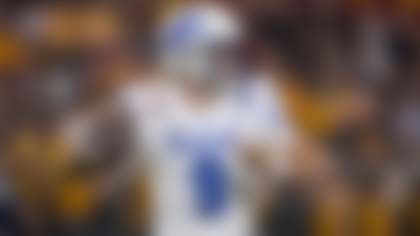The scouting community can't stop raving about the number of playmakers in the 2020 draft class, which is loaded with blue-chip players throughout -- but while much of the public's attention has been directed at quarterbacks, most of the five-star playmakers are on the defensive side of the ball or at the wide receiver and offensive tackle positions.
That said, signal-callers Joe Burrow and Tua Tagovailoaare the unquestioned headliners of the draft, with each potential QB1 offering teams a mix of leadership and playmaking skills. Burrow is a lock to be the No. 1 overall pick based on his magical final season at LSU, in which he dazzled evaluators with his ability to distribute the ball like a pass-first point guard running a fast break on the basketball court. He shows remarkable vision, anticipation and timing getting the ball to his playmakers on the move to allow them to take advantage of scoring opportunities. Burrow's trust in his pass-catchers is reflected in his aggressiveness as a passer, particularly on back-shoulder fades along the boundary.
Tagovailoa's injury history -- including surgeries on both ankles and a dislocated hip that ended his final season at Alabama in November -- has cast a black cloud over his evaluation, but scouts are smitten with his talents as a quick-rhythm passer. He shows uncanny snap-to-release quickness, and his pinpoint passing ability will endear him to offensive coordinators who operate "connect the dots" schemes that require a quick decision-maker play the position. He is a more talented player than Burrow, with a higher ceiling, capable of being an elite player -- a left-handed Drew Brees -- if he stays healthy. Burrow, by contrast, is an older QB, so I don't know how much improvement he will make as a pro. Plus, he's a bit of a one-year wonder thus far, having exploded from 2018 to '19. He has B-to-B-plus arm talent, and he benefitted from playing in a pro-style system against SEC opponents who weren't prepared for it. I see him as more of a "system player" than a transcendent talent, which is why he's in the Pro Bowl category below.
Oregon's Justin Herbert and Utah State's Jordan Love have their fans in the scouting community, but each player ranks outside the VIP circle of elite prospects in the class.
The pass-catchers, though, are absolute studs, with a number of potential stars certain to rise from the Day 2 ranks. Alabama's Jerry Jeudy, Oklahoma's CeeDee Lamb, Alabama's Henry Ruggs and LSU's Justin Jefferson are the cream of the crop, but don't dismiss the chances of USC's Michael Pittman, Penn State's KJ Hamler, TCU's Jalen Reagor and South Carolina's Bryan Edwards emerging as significant contributors early in their respective careers.
Running backs aren't valued at a premium in this class, but that doesn't mean the draft lacks premier ball-carriers. D'Andre Swift (Georgia), J.K. Dobbins (Ohio State) and Jonathan Taylor (Wisconsin) have the tools to be lead backs, with each runner displaying the toughness to handle the rigors of a 20-plus carry workload while also flashing the soft hands and ball skills to be effective receivers in the passing game.
At offensive tackle, Iowa's Tristan Wirfs, Alabama's Jedrick Wills, Louisville's Mekhi Becton and Georgia's Andrew Thomas comprise the "Big Four" as blue-chip players boasting the combination of size, strength and athleticism that enables them to play on the right or left side of the line. USC's Austin Jackson, Houston's Joshua Jones and Boise State's Ezra Cleveland might rank a notch below the elites, but they are solid starters with long-term potential.
On the defensive side of the ball, Ohio State edge rusher Chase Young is a gold jacket prospect with a collection of traits that could make him one of the best to play the position in the NFL. Sure, that is lofty praise for a defensive end with only three years of collegiate experience, but one would be hard-pressed to find a find big, athletic pass rusher with a polished technical game that rivals Young's ability at this stage of his career.
Iowa's A.J. Epenesa, LSU's K'Lavon Chaisson and Penn State's Yetur Gross-Matos are also intriguing pass rushers, but each has a potentially fatal flaw (Epenesa's lack of explosiveness, Chaisson's lack of sack production and Gross-Matos' lack of first-step quickness) that prevents scouts from stamping them as "can't miss."
Auburn's Derrick Brown and South Carolina's Javon Kinlaw are the crown jewels of the defensive tackle group. Brown, in particular, is a dominant interior force with a non-stop motor and a power-based game that could make him an unstoppable defender at the point of attack. He is a five-star talent, and some scouts would suggest he should be in the conversation with Young as the best prospect in the class.
Clemson's Isaiah Simmons is an explosive Swiss Army knife-like defender with a multifaceted game that could enable a creative defensive coordinator to deploy him at a number of positions to stymie an elite offense. He has logged 100-plus snaps at five different positions, and that versatility certainly separates him from other linebackers. Oklahoma's Kenneth Murray, LSU's Patrick Queen and Wisconsin's Zack Baun have also earned solid marks for their potential as Day 1 starters on the second level.
The defensive backs in the class possess the size, length and ball skills that defensive coordinators desire in cornerbacks and safeties. At cornerback, Jeff Okudah of Ohio State and CJ Henderson of Florida are "plug-and-play" defenders with rock-solid games built on athleticism and technique. Although Okudah is more of a man-to-man corner with an overall toughness that stands out on tape, Henderson's ball skills as a zone corner make him just as intriguing as a prospect.
Xavier McKinney (Alabama) and Grant Delpit (LSU) are viewed as the top safeties, but Jeremy Chinn could crash the party as a late-rising prospect. The Southern Illinois standout has an impressive combination of skills as a big-bodied safety with cornerback experience and linebacker-like toughness.
ALL-PROS
These are the elite prospects in the class. They should rank among the top five players at their respective positions in two to three years. They are ordered according to how they grade out in my book.
1) Chase Young, DE, Ohio State
2) Derrick Brown, DT, Auburn
3) Isaiah Simmons, LB/S, Clemson
4) Tua Tagovailoa, QB, Alabama
5) Jeff Okudah, CB, Ohio State
PRO BOWLERS
These prospects are regarded as difference-makers based solely on their talent. They should make immediate contributions as rookies and rank among the top 10 at their position within two to three years. They are ordered according to how they grade out in my book.
1) Joe Burrow, QB, LSU
2) Tristan Wirfs, OT, Iowa
3) Jedrick Wills, OT, Alabama
4) Mekhi Becton, OT, Louisville
5) Jerry Jeudy, WR, Alabama
6) CeeDee Lamb, WR, Oklahoma
7) CJ Henderson, CB, Florida
8) Henry Ruggs III, WR, Alabama
9) Javon Kinlaw, DT, South Carolina
10) Justin Jefferson, WR, LSU
RED STARS
On the "Move the Sticks" podcast, Daniel Jeremiah and I have discussed how scouts will stand on the table for guys they believe will outperform their draft status. In the scouting world, these players are called "red star" guys because they are destined to make their mark in the league, regardless of where they are drafted. After surveying the 2020 class for players with the right skills and intangibles to perform better than their draft grades, here are my five red-star prospects to watch:
1) Zack Baun, LB, Wisconsin: The former high school quarterback blossomed into a spectacular defensive playmaker during his five-year term in Madison (including a redshirt freshman year in 2015). Baun is an explosive second-level defender with dynamic pass-rush skills and sideline-to-sideline playmaking ability. He is a rare specimen as a SAM linebacker with the capacity to hunt quarterbacks while also flashing instincts and awareness in coverage. Additionally, No. 56 plays at a fanatical pace that overwhelms opponents over the course of a 60-minute game. It remains to be seen whether his positive test for a diluted sample at the NFL Scouting Combine will impact his draft stock. But considering Baun's diverse skills and non-stop motor, the Wisconsin product could be a major headache for offensive coordinators around the NFL for the next decade.
2) Michael Pittman WR, USC: It's uncommon for a WR1 to be a standout special teams contributor, but that's what the USC standout brings to the table as a 6-foot-4, 223-pound dynamo on the perimeter. Pittman bullies defensive backs with his superior size and strength while displaying soft hands and outstanding ball skills. He would be an ideal "chain mover" for an offense that features an assortment of in-breaking routes (slants, crossers and digs) over the middle of the field. Pittman's length, big body and post-up skills expand the strike zone for the quarterback, particularly if the quarterback is an anticipatory thrower with the courage to throw into traffic between the hashes. With every NFL offensive coordinator searching for a tough, dependable pass-catcher with a willingness to handle the dirty work on the perimeter, Pittman should enjoy a lengthy career as a blue-collar playmaker in the passing game.
3) Darnay Holmes, CB, UCLA: The best nickel corner in the 2020 class possesses a unique set of skills that should enable him to shine immediately in the league. Holmes' combination of speed, agility, intelligence, competitiveness and toughness are ideal for the slot corner position, which is viewed as the 12th starting spot on defenses in today's game. The UCLA product has the capacity to cover shifty receivers in tight quarters and also understands how to maintain his leverage, to maximize the help available to him from linebackers and safeties. Holmes' high football IQ and his overall awareness of coverage would make him ideally suited for the slot corner role in a multi-faceted scheme that demands a lot from the nickel back. Given Holmes' toughness, tackling and competitive spirit, the move inside could help him become a game-changer at the next level.
4) Logan Wilson, LB, Wyoming: It is difficult to find a hard-hitting inside linebacker with outstanding production as a tackling machine and ball-hawk. Wilson amassed 100-plus tackles in three of his four seasons with the Cowboys while finishing his career with 10 interceptions. As an instinctive defender with exceptional diagnostic skills and reactions, he flies to the ball without hesitation and delivers the thump to ball carriers. Wilson's ability to control the tackle-to-tackle box in the run game is impressive, but his playmaking ability as a pass defender could vault him to elite status as a pro. He is one of the best underneath zone defenders to enter the draft in years, exhibiting uncommon awareness, anticipation and ball skills. He is the perfect "run through" player in a Tampa 2 scheme, possessing the size, length and athleticism to carry tight ends and slot receivers down the seam while also displaying the vision and awareness to react quickly to underneath throws in his area. If Wilson lands with a zone-heavy team that relies on the linebacker to patrol the middle of the field like a security guard, the Wyoming standout could emerge as a four-star playmaker.
5) Cam Akers, RB, Florida State: Day 2 has routinely been the sweet spot for snagging star running backs over the past decade. Frank Gore, LeSean McCoy, Le'Veon Bell and Dalvin Cook are a few examples of Day 2 picks who eventually earned Pro Bowl status as RB1s. Akers could be the next great runner to become a superstar at the next level. As a rugged runner with outstanding vision, balance and body control, the Florida State star can weave through traffic with ease while also flashing enough strength, power and pop to run through arm tackles. In addition, Akers displays soft hands and outstanding ball skills catching passes on the perimeter, particularly on swings and screens designed to get him the ball in space with a handful of blockers around him. He is a nightmare to contain in the passing game, and his ability to pick up chunk yards that way could make him a force as a pro.
Follow Bucky Brooks on Twitter @BuckyBrooks.












